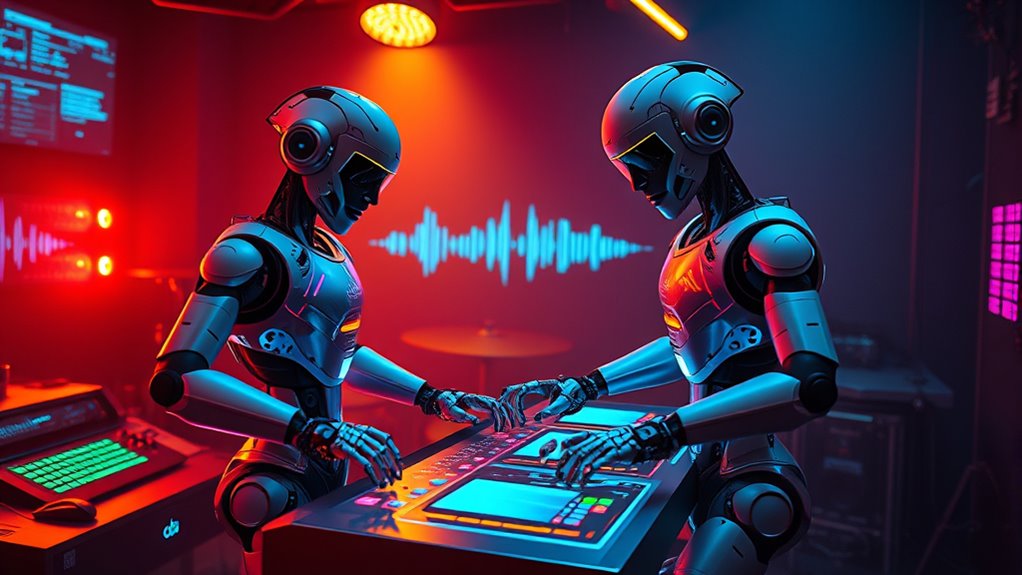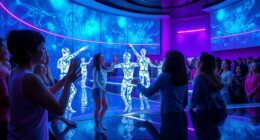AI jam partners now let you improvise music on the fly by listening and responding in real time, using advanced pattern recognition and sound adaptation techniques. These systems analyze musical styles, match your mood, and create spontaneous melodies, making collaboration seamless and inspiring. They help you push boundaries and explore new sounds effortlessly. If you keep exploring, you’ll discover how these innovations are transforming live performances and creative sessions everywhere.
Key Takeaways
- AI jam partners analyze real-time sound textures to improvise melodies and harmonies seamlessly during live music sessions.
- Advanced pattern recognition allows AI to predict notes and respond instantly to human musicians’ improvisations.
- AI employs real-time sound adaptation, matching evolving musical styles for spontaneous and dynamic collaborations.
- AI systems incorporate cultural and environmental factors to enhance improvisation authenticity and sustainability.
- These AI tools foster creative experimentation, enabling artists to explore new genres and emotional expressions on the fly.
The Evolution of AI in Musical Collaboration

The evolution of AI in musical collaboration has transformed how artists create and perform music. It has opened new avenues for exploring musical spontaneity, allowing artists to experiment beyond traditional boundaries. Early AI tools offered basic assistance, but now, advanced systems can generate melodies or suggest harmonies in real time, enhancing creative spontaneity. This evolution empowers musicians to improvise more freely, blending human intuition with machine intelligence. As AI continues to develop, it fosters a dynamic environment where spontaneity thrives, making musical collaboration more innovative, exciting, and accessible for artists worldwide. Additionally, essential oils for improvisation can enhance focus and inspiration during creative sessions, further enriching the collaborative experience.
How AI Systems Listen and Respond in Real Time

You might wonder how AI systems pick up on live music and respond instantly. They use advanced audio processing techniques to interpret sounds and generate musical responses on the fly. This allows for seamless synchronization with human musicians, creating a dynamic and improvisational collaboration. The ability to analyze and adapt to various sound textures and high refresh rates ensures real-time responsiveness and fluid musical interactions.
Live Audio Processing Techniques
AI systems process live audio by continuously analyzing incoming sound signals in real time, allowing them to respond instantly to musical nuances. This involves sophisticated techniques such as algorithmic harmony, which helps generate fitting musical responses, and sonic adaptability, enabling the AI to adjust its output based on the evolving soundscape. These processes ensure seamless interaction during improvisation sessions. To visualize how this works, consider the table below:
| Technique | Purpose |
|---|---|
| Algorithmic Harmony | Creates harmonious musical responses |
| Sonic Adaptability | Adjusts to dynamic sound environments |
| Real-Time Signal Analysis | Enables instant response to live input |
This combination allows AI jam partners to listen actively and respond precisely, mimicking human musical intuition. Additionally, understanding Honda Tuning can inspire innovative approaches to optimizing audio processing systems in musical AI applications.
Adaptive Musical Responses
When musicians improvise, their responses depend on listening carefully to the evolving soundscape; similarly, AI systems actively analyze incoming audio to craft appropriate musical reactions in real time. They recognize shifts in genre blending, allowing them to adapt their style seamlessly during improvisation. They also interpret emotional expression conveyed through dynamics, tone, and rhythm, enabling more nuanced responses. This adaptability guarantees the AI’s contributions feel organic and responsive, fostering a dynamic musical dialogue. By continuously listening and adjusting, AI partners can mirror human spontaneity, making their improvisations more engaging. Additionally, understanding sound vibrations can enhance the way AI modulates responses to promote a more immersive experience. This real-time responsiveness bridges the gap between human intuition and machine precision, creating collaborative experiences where AI enhances the emotional depth and genre diversity of live performances.
Synchronization With Human Musicians
As musicians perform together, AI systems listen intently to capture the nuances of their playing, enabling real-time synchronization. They analyze rhythm synchronization to stay in time with your beat and pitch matching to align with your melodies. AI responds instantly, adjusting tempo and tone to complement your improvisation. This seamless coordination creates a cohesive musical experience where both human and AI perform as one. Additionally, advanced real-time analysis techniques allow AI to better understand and adapt to complex musical expressions.
Techniques Behind AI-Driven Improvisation
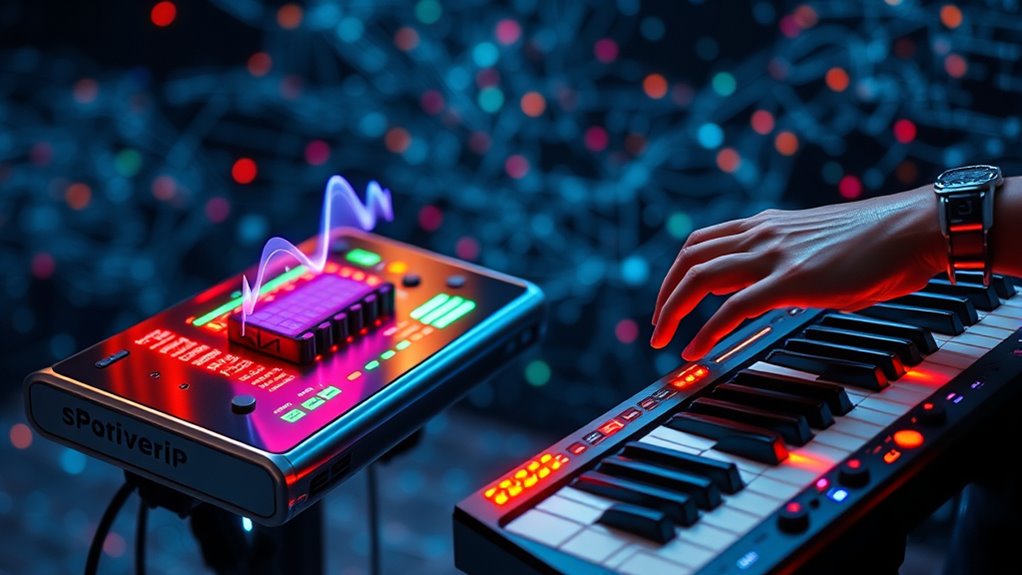
AI uses pattern recognition algorithms to understand musical styles and predict upcoming notes. It then employs real-time sound adaptation to match the evolving jam, making seamless adjustments. Collaborative signal processing helps AI and human musicians work together smoothly, creating a dynamic improvisation experience. Additionally, AI can incorporate elements of musical diversity to enrich its improvisations and better respond to various styles.
Pattern Recognition Algorithms
Pattern recognition algorithms form the backbone of AI-driven improvisation by enabling machines to analyze and interpret musical data in real-time. You rely on rhythm detection to identify patterns in timing, allowing the AI to stay in sync with your tempo and groove. Motif recognition helps the system identify recurring melodic or harmonic themes, so it can build upon or vary them naturally. These algorithms sift through vast amounts of musical information quickly, spotting subtle patterns that guide improvisation. By understanding rhythmic structures and motifs, the AI can generate coherent, contextually appropriate responses. This process guarantees your AI partner improvises seamlessly, responding intuitively to your playing. Additionally, incorporating environmental considerations ensures the system’s operation supports sustainable and eco-friendly practices. Overall, pattern recognition algorithms are essential for creating dynamic, responsive, and musically meaningful AI improvisation.
Real-Time Sound Adaptation
Real-time sound adaptation is crucial for AI-driven improvisation because it allows the system to respond instantly to your playing, creating a seamless musical dialogue. By leveraging advanced improvisation frameworks, the AI can interpret your nuances and adjust its output on the fly. Central to this is algorithmic harmony, which guarantees that the AI’s responses stay in tune with your improvisation, maintaining musical coherence. Additionally, understanding support hours helps ensure the technology is accessible when needed. With these techniques, you experience:
- A dynamic exchange that feels intuitive and alive
- Spontaneous musical conversations that inspire creativity
- Immediate adjustments that reflect your emotional expression
- Fluid transitions between melodies and rhythms
- An immersive experience where the AI feels like a true musical partner
Collaborative Signal Processing
Collaborative signal processing forms the backbone of AI-driven improvisation by enabling systems to analyze and interpret your musical input with high precision. You’ll notice how the AI adapts algorithms in real-time, fine-tuning its responses through algorithm adaptation to match your style. Signal modulation allows the system to dynamically adjust audio features, ensuring seamless integration with your performance. This process involves analyzing your notes, rhythm, and expression, then modifying its own output to create harmonious interactions. By continuously evolving its signal processing strategies, the AI can respond more naturally, making improvisation feel spontaneous and organic. This synergy between your input and the AI’s processing techniques creates a fluid, collaborative musical experience that adapts instantly, making every jam session uniquely engaging.
Examples of AI Jam Partners in Action
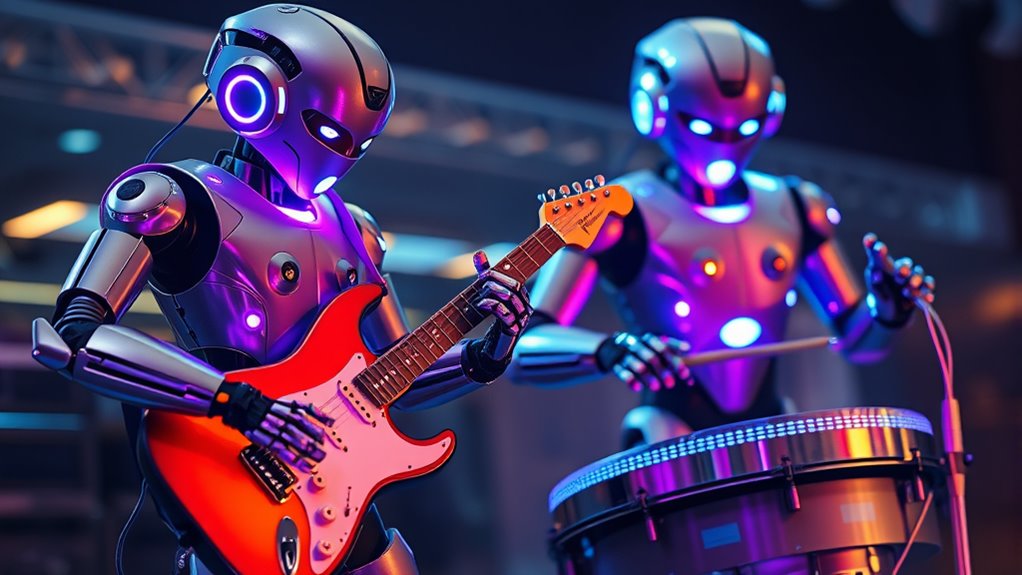
AI jam partners have already demonstrated their ability to create dynamic and engaging musical collaborations. You can experience AI’s emotional expression as it responds intuitively, adding depth and nuance to performances. These systems adapt to diverse cultural influences, blending traditional melodies with modern sounds seamlessly. Additionally, AI-driven sound synthesis techniques enable the generation of entirely new textures and effects in real time.
AI jam partners showcase emotional depth and cultural fusion, creating spontaneous, engaging musical collaborations with seamless traditional and modern blend.
Some notable examples include:
- AI improvising soulful jazz solos during live sessions
- Collaborative performances combining AI and human musicians from different cultures
- AI generating spontaneous, emotionally charged melodies in real time
- Cross-cultural fusion projects that showcase diverse musical traditions
- AI-driven band setups that respond to audience energy instantly
These examples reveal how AI brings emotional depth and cultural richness to spontaneous music creation, making each jam unique and memorable.
Benefits of Using AI for Spontaneous Music Creation

Using AI for spontaneous music creation boosts your creativity and sparks new ideas you might not have considered. It also makes collaborating in real-time smoother, so you can focus on the music without technical hurdles. Plus, AI encourages exploring diverse musical styles, expanding your artistic horizons effortlessly. Incorporating generative AI techniques can further enhance the authenticity and variety of the musical outputs.
Enhanced Creativity and Innovation
When musicians embrace AI partners for spontaneous creation, they open new levels of creativity and innovation. AI encourages emotional expression by offering unexpected melodies and harmonies that push boundaries. It also fosters genre fusion, blending styles you might not have combined alone. With AI, you can experiment freely, revealing fresh ideas and sounds. This collaborative process sparks inspiration, leading to unique musical journeys. You feel empowered to break traditional rules, creating emotionally resonant pieces. AI becomes a tool that amplifies your artistic voice, transforming spontaneous sessions into innovative masterpieces.
- Discover uncharted musical territories
- Express raw, authentic emotions
- Break genre boundaries effortlessly
- Inspire daring improvisations
- Elevate your creative potential
Real-Time Collaboration Ease
Thanks to real-time AI assistance, spontaneous music creation becomes more seamless and responsive. You’ll notice how user interaction feels more intuitive, allowing you to focus on your creativity rather than technical hurdles. The AI adapts instantly to your input, offering suggestions or accompaniment that match your mood and style. This smooth collaboration enhances your overall user experience, making improvisation sessions more engaging and less stressful. With AI acting as a responsive partner, you can experiment freely without worrying about timing or synchronization issues. The ease of real-time collaboration encourages you to explore new musical ideas on the fly, fostering a sense of spontaneity and flow. Ultimately, AI simplifies the collaborative process, helping you produce music more fluidly and confidently.
Diverse Musical Exploration
The flexibility of real-time AI collaboration opens up a world of musical possibilities, encouraging you to explore diverse styles and genres effortlessly. With AI as your partner, you can blend genre fusion seamlessly, creating fresh sounds that push boundaries. It helps you incorporate cultural influences, enriching your music with authentic, global flavors. This spontaneous exploration sparks emotional connections and inspires innovation. You might experience:
- Discovering new fusion styles that surprise your audience
- Merging traditional melodies with modern beats
- Experimenting with cultural influences to craft unique soundscapes
- Breaking genre barriers without limitations
- Enhancing creativity through unpredictable, collaborative moments
AI empowers you to embrace spontaneity, making every jam session an adventure in musical diversity. The result? Music that’s vibrant, authentic, and truly expressive.
Challenges and Limitations of AI Improvisation
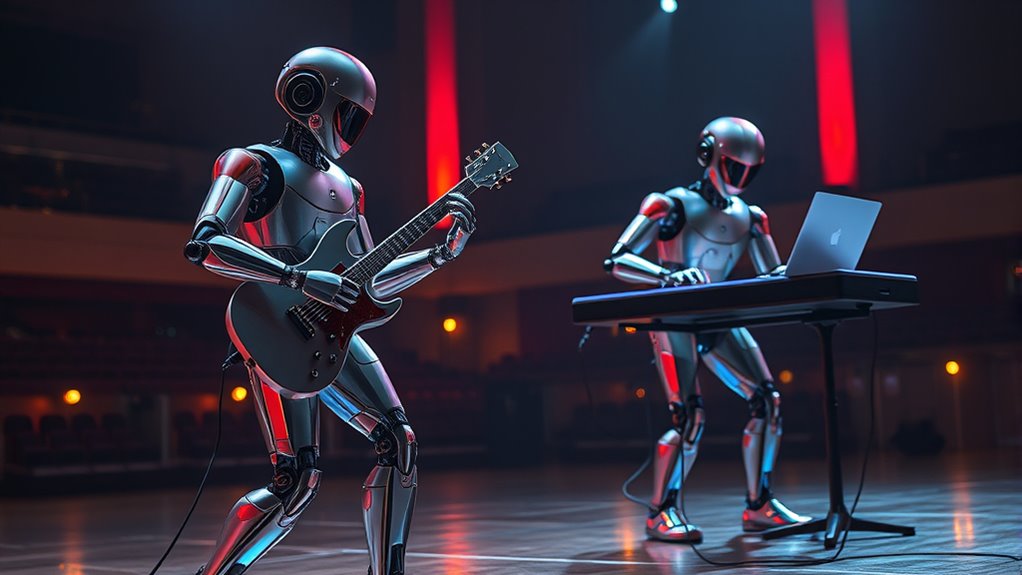
Despite impressive advances, AI improvisation faces significant challenges that limit its effectiveness. Ethical dilemmas arise as AI systems generate music that blurs the line between human and machine creativity, raising questions about authorship and originality. You might find that AI lacks the genuine emotional depth and spontaneity a human musician brings to improvisation, which affects the perception of creative authenticity. Additionally, AI struggles with understanding cultural nuances and context, leading to performances that can feel mechanical or uninspired. These limitations mean AI still can’t fully replicate the intuitive and emotional connection that improvising musicians share with their audience. As a result, AI remains a tool rather than a true partner in creative musical exploration, highlighting the ongoing need to address these core challenges.
The Role of Machine Learning in Enhancing Musical Interaction

Machine learning has become a powerful tool for enhancing musical interaction by enabling AI systems to adapt and respond more dynamically to human musicians. It allows AI to listen, learn, and improvise in real-time, creating a more organic collaboration. However, this progress raises important questions about AI ethics and algorithm transparency. You might feel excited by the spontaneity AI can bring, yet concerned about biases or hidden decision-making processes. Consider how transparency builds trust, ensuring you understand how the AI responds. The potential for emotional connection grows when AI adapts authentically.
AI’s real-time learning fosters authentic musical bonds while transparency ensures trust and ethical collaboration.
- Feel the thrill of seamless musical dialogue
- Experience trust through transparent algorithms
- Embrace ethical AI that respects artistry
- Witness AI learning your unique style
- Feel empowered by authentic improvisation
Future Possibilities for AI and Human Musicians
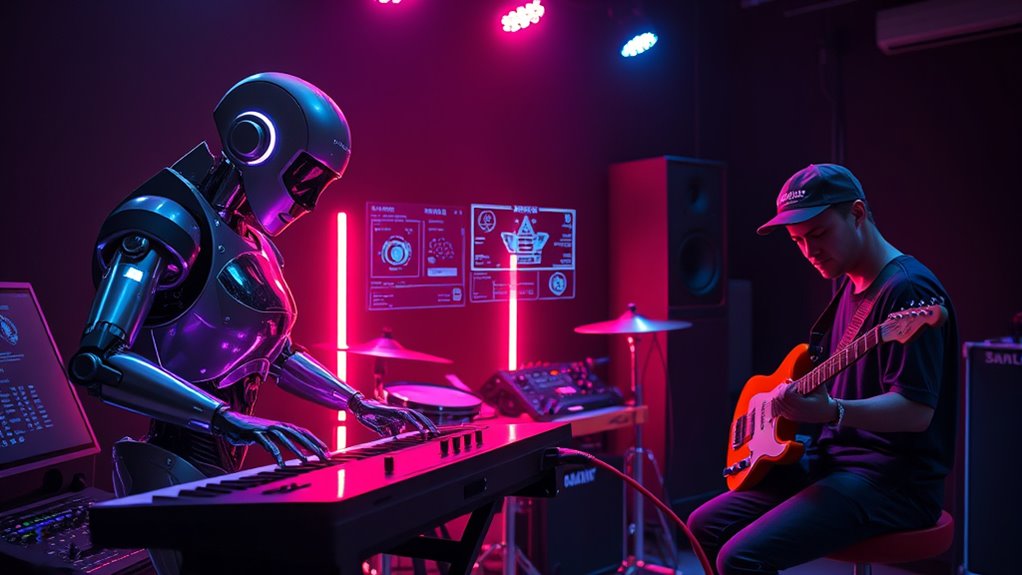
As AI continues to evolve alongside human musicians, the future holds exciting possibilities for seamless collaboration and creative innovation. You might soon see AI tools that adapt instantly to your style, fostering more spontaneous performances. However, AI ethics will play a vital role, ensuring that AI-generated music respects originality and artist rights. As collaborations grow, clear music licensing frameworks will be essential to protect creators and define ownership of AI-assisted compositions. These advancements could democratize music creation, making it accessible to more people. You’ll likely experience more personalized, dynamic musical experiences while maintaining ethical standards and fair licensing. This synergy could open new genres and artistic expressions, pushing the boundaries of what’s possible in musical collaboration.
Ethical Considerations in AI-Generated Music

The rapid advancement of AI in music creation raises important ethical questions that can’t be overlooked. You must consider how AI impacts intellectual property, as original compositions could be copied or altered without proper attribution. There’s also concern about cultural appropriation, where AI may inadvertently borrow from marginalized cultures without respect or acknowledgment.
You might feel anger when AI reproduces a musician’s unique style without consent. Disappointment can grow if AI erodes artists’ rights and recognition. Anxiety arises over the loss of authentic human expression, and frustration emerges when AI blurs cultural boundaries. These issues challenge us to create fair, respectful guidelines that protect artists’ rights and preserve cultural integrity in a rapidly evolving digital landscape.
Integrating AI Jam Partners Into Live Performances
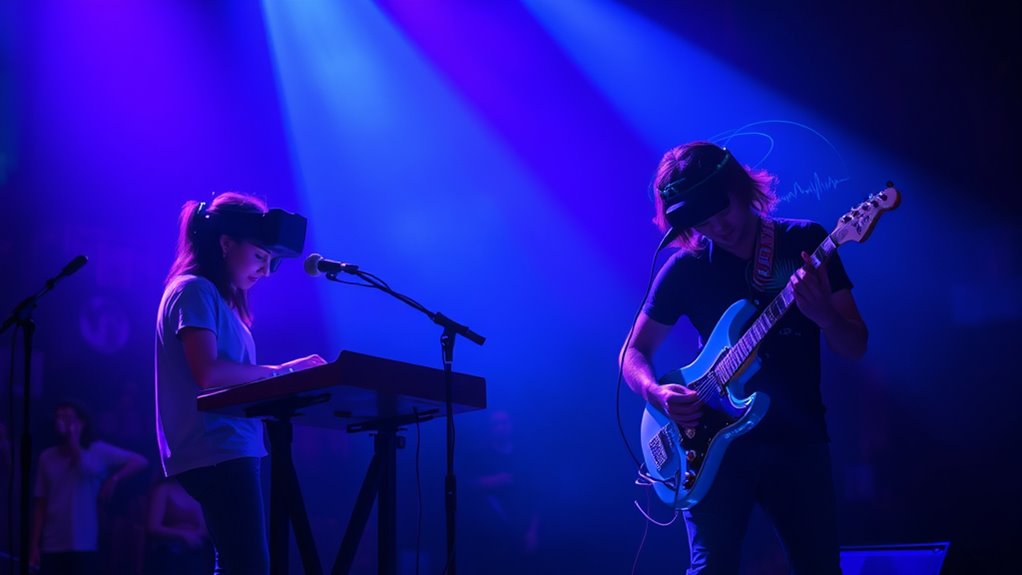
Integrating AI jam partners into live performances offers musicians new avenues for creativity and spontaneity. By using AI tools, you can improvise seamlessly with digital partners, enhancing your set without worrying about licensing complexities, since AI-generated music often bypass traditional music licensing issues. This integration also boosts audience engagement, as you can craft dynamic, unpredictable performances that captivate listeners. AI can adapt in real time, responding to your playing and creating a more interactive experience. Live AI collaborations enable you to push musical boundaries and experiment without the need for additional musicians. With the right setup, AI becomes a versatile, intuitive partner that elevates your performance, making each show unique while fostering a deeper connection with your audience.
Frequently Asked Questions
How Do AI Jam Partners Adapt to Different Musical Genres?
When exploring how AI jam partners adapt to different musical genres, you notice their impressive stylistic flexibility. They analyze your input and adjust their responses to match the genre’s unique rhythms, harmonies, and textures. Through genre adaptation, AI partners stay in sync with your style, whether jazz, rock, or classical, making the improvisation seamless. Their ability to shift styles quickly helps create dynamic, genre-specific musical interactions that feel natural and engaging.
Can AI Learn From Live Audience Feedback During Improvisation?
Think of AI as a jazz musician catching the rhythm of the crowd. During improvisation, it can learn from audience interaction and adapt in real-time. When you give feedback, AI processes this improvisation feedback, adjusting melodies and tempo accordingly. This dynamic exchange helps AI create more engaging, personalized performances, making the experience feel like a lively conversation where your reactions shape the music directly.
What Hardware Is Required for Real-Time AI Musical Collaboration?
For real-time AI musical collaboration, you need hardware that minimizes latency issues. A powerful computer with a fast CPU and GPU ensures smooth processing, while a high-quality audio interface reduces delays in sound transfer. You should also have low-latency headphones or monitors and reliable MIDI controllers if applicable. This setup helps you stay in sync during improvisation, making your collaboration seamless and expressive without frustrating delays.
How Do AI Systems Handle Unexpected Musical Cues From Human Players?
Ever wonder how AI systems respond when you throw unexpected musical cues? They excel at dynamic improvisation, quickly analyzing your input and adapting seamlessly. This allows the AI to match your emotional nuance, creating a genuine musical conversation. By continuously learning and updating in real time, the AI anticipates your moves, maintaining harmony even in surprises. It’s like having a partner who’s always in sync, ready for whatever musical twist you bring.
Are There Limitations to Ai’s Ability to Emulate Human Emotional Expression?
You might wonder if AI can truly capture human emotional nuance and expressive range. While AI models analyze patterns and generate responses, they often lack genuine emotional depth. They can mimic expressive cues but may miss subtle emotional shifts that humans naturally convey. So, AI’s ability to emulate human emotional expression is limited, especially when it comes to spontaneous emotional nuance, which remains a challenge for even the most advanced systems.
Conclusion
As you explore AI’s role in musical improvisation, it’s fascinating how technology and human creativity unexpectedly intertwine. Just like a spontaneous jam session, AI partners adapt and respond in real time, blurring lines between machine and artist. This evolving dance hints at a future where innovation and tradition collide seamlessly, reminding you that sometimes, the most remarkable moments emerge from the unanticipated harmony of human ingenuity and artificial intelligence.

